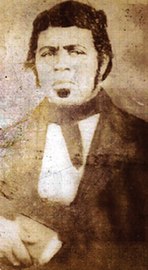Top Qs
Timeline
Chat
Perspective
List of presidents of the United States who owned slaves
From Wikipedia, the free encyclopedia
Remove ads
Remove ads
Slavery was legal in the United States from its beginning as a nation, having been practiced in North America from early colonial days. The Thirteenth Amendment to the United States Constitution formally abolished slavery in 1865, immediately after the end of the American Civil War.[1]
Twelve U.S. presidents owned slaves at some point in their lives; of these, eight owned slaves while in office. Ten of the first twelve American presidents owned slaves, the only exceptions being John Adams and his son John Quincy Adams, neither of whom approved of slavery. George Washington, the first president, owned slaves, including while he was president. Andrew Jackson was an interregional slave trader until at least the War of 1812. Zachary Taylor was the last one who owned slaves during his presidency, and Ulysses S. Grant was the last president to have owned a slave at some point in his life. Of these presidents who owned slaves, Thomas Jefferson owned the most over his lifetime, with 600+ slaves, followed closely by Washington. Woodrow Wilson was the last president born into a household with slave labor, though the Civil War and abolition concluded during his early childhood.[2]
Remove ads
Presidents who owned slaves
Summarize
Perspective
Remove ads
Gallery
Summarize
Perspective
American slavery and the presidents
- John Trumbull's 1780 portrait George Washington also depicts a man believed to be Washington's enslaved valet William Lee (Metropolitan Museum of Art 24.109.88)
- Miscaptioned c. 1937 photo of William Andrew Johnson, who had been enslaved by Andrew Johnson, and was believed to be the last surviving person enslaved by a U.S. president.[24] Andrew Johnson bid $500 for William A. Johnson's mother Dolly Johnson[25]
- Alfred Jackson (1812–1901) lived at The Hermitage longer than any other person
- Elias Polk was enslaved by James K. Polk at his farm in Maury County, Tennessee
- In 1875, the St. Louis Globe published this interview with Moses Key, a former slave of James Monroe
- Anna Judge, "nearly a hundred years old" and formerly enslaved by William Henry Harrison, died in a kitchen-fire accident in 1899
- In 1862, Zachary Taylor's daughter requested financial compensation from the U.S. government for the value of Jane Webb, a formerly enslaved woman who had accompanied her father to the White House during his presidency[26]
- Henry Hawkins (1819–1917) accompanied Zachary Taylor on his Mexican-American War campaigns, and was to be interred at the mausoleum of Dick Taylor in Metairie Cemetery, New Orleans (Natchez Democrat, July 6, 1917)
- 1870 federal census of Ross County, Ohio; the enumerator broke protocol to note of Madison Hemings, "This man is the son of Thomas Jefferson."
- Madison's brother and fellow slave of Thomas Jefferson Eston Hemings moved to Wisconsin and changed his name to Jefferson; Eston's son John Wayles Jefferson (pictured) was a U.S. Army officer during the Civil War
- Paul Jennings wrote A Colored Man's Reminiscences of James Madison and helped plan what became known as the Pearl incident
Three U.S. Presidents, George Washington, Thomas Jefferson, and Andrew Jackson are known to have placed runaway slave ads, seeking to recapture fugitives "Sandy",[27] Oney Judge, and in the case of Jackson, both "a mulatto Man Slave" in 1804, and Gilbert in 1822.[28]
- Thomas Jefferson and slavery: "Run away from the subscriber..." (Virginia Gazette, 1769)
- George Washington and slavery: Oney Judge "absconded from the household of the President of the United States..." (Pennsylvania Gazette, May 24, 1796)
- "Stop the Runaway. Fifty Dollars Reward." Andrew Jackson offered to pay extra for more violence (The Tennessee Gazette, October 3, 1804)
Remove ads
See also
- Historical rankings of presidents of the United States § Scholar surveys of diversity and racism
- List of children of presidents of the United States
- Abolitionism in the United States
- District of Columbia Compensated Emancipation Act (1862), which ended slavery in Washington, D.C.
- John Quincy Adams and abolitionism
- Lists of United States public officials who owned slaves
- Slavery in the District of Columbia
- Treatment of slaves in the United States
- Polk Taylor, reportedly owned by Zachary Taylor's daughter
- Eva Bates, reportedly employed by both John Adams and James Monroe
Notes
- If Van Buren re-enslaved Tom, he risked alienating northern political supporters who opposed slavery. If he publicly refused to return Tom to slavery, he risked alienating pro-slavery supporters in the southern states. By taking no action, Van Buren eliminated the possibility of losing supporters from either side.
References
Wikiwand - on
Seamless Wikipedia browsing. On steroids.
Remove ads













